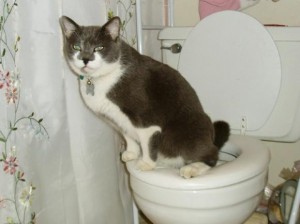Why Flushing Cat Poop Down Your Toilet May Cause Problems - Tips for Proper Handling
Why Flushing Cat Poop Down Your Toilet May Cause Problems - Tips for Proper Handling
Blog Article
Just about every person will have their own individual idea on the subject of How to Dispose of Cat Poop and Litter Without Plastic Bags.

Intro
As pet cat owners, it's necessary to bear in mind just how we get rid of our feline friends' waste. While it may seem convenient to flush feline poop down the bathroom, this technique can have harmful consequences for both the atmosphere and human health.
Ecological Impact
Purging pet cat poop introduces unsafe microorganisms and bloodsuckers right into the water system, posturing a substantial danger to marine ecological communities. These contaminants can negatively influence marine life and concession water high quality.
Health Risks
In addition to ecological problems, purging feline waste can additionally pose health risks to people. Cat feces may contain Toxoplasma gondii, a bloodsucker that can create toxoplasmosis-- a possibly serious disease, specifically for pregnant ladies and people with damaged immune systems.
Alternatives to Flushing
Fortunately, there are much safer and a lot more responsible means to throw away cat poop. Think about the complying with alternatives:
1. Scoop and Dispose in Trash
One of the most common method of dealing with pet cat poop is to scoop it into a naturally degradable bag and toss it in the trash. Make sure to utilize a devoted trash inside story and throw away the waste immediately.
2. Use Biodegradable Litter
Go with biodegradable feline trash made from materials such as corn or wheat. These clutters are eco-friendly and can be safely dealt with in the garbage.
3. Bury in the Yard
If you have a yard, think about burying pet cat waste in a marked location far from vegetable yards and water sources. Be sure to dig deep adequate to avoid contamination of groundwater.
4. Mount a Pet Waste Disposal System
Buy a family pet garbage disposal system particularly designed for cat waste. These systems make use of enzymes to break down the waste, lowering odor and environmental impact.
Conclusion
Liable pet dog possession prolongs beyond giving food and shelter-- it additionally entails correct waste monitoring. By avoiding flushing feline poop down the toilet and selecting alternate disposal approaches, we can reduce our ecological footprint and protect human health.
Why Can’t I Flush Cat Poop?
It Spreads a Parasite
Cats are frequently infected with a parasite called toxoplasma gondii. The parasite causes an infection called toxoplasmosis. It is usually harmless to cats. The parasite only uses cat poop as a host for its eggs. Otherwise, the cat’s immune system usually keeps the infection at low enough levels to maintain its own health. But it does not stop the develop of eggs. These eggs are tiny and surprisingly tough. They may survive for a year before they begin to grow. But that’s the problem.
Our wastewater system is not designed to deal with toxoplasmosis eggs. Instead, most eggs will flush from your toilet into sewers and wastewater management plants. After the sewage is treated for many other harmful things in it, it is typically released into local rivers, lakes, or oceans. Here, the toxoplasmosis eggs can find new hosts, including starfish, crabs, otters, and many other wildlife. For many, this is a significant risk to their health. Toxoplasmosis can also end up infecting water sources that are important for agriculture, which means our deer, pigs, and sheep can get infected too.
Is There Risk to Humans?
There can be a risk to human life from flushing cat poop down the toilet. If you do so, the parasites from your cat’s poop can end up in shellfish, game animals, or livestock. If this meat is then served raw or undercooked, the people who eat it can get sick.
In fact, according to the CDC, 40 million people in the United States are infected with toxoplasma gondii. They get it from exposure to infected seafood, or from some kind of cat poop contamination, like drinking from a stream that is contaminated or touching anything that has come into contact with cat poop. That includes just cleaning a cat litter box.
Most people who get infected with these parasites will not develop any symptoms. However, for pregnant women or for those with compromised immune systems, the parasite can cause severe health problems.
How to Handle Cat Poop
The best way to handle cat poop is actually to clean the box more often. The eggs that the parasite sheds will not become active until one to five days after the cat poops. That means that if you clean daily, you’re much less likely to come into direct contact with infectious eggs.
That said, always dispose of cat poop in the garbage and not down the toilet. Wash your hands before and after you clean the litter box, and bring the bag of poop right outside to your garbage bins.
https://trenchlesssolutionsusa.com/why-cant-i-flush-cat-poop/

We had been made aware of that write-up about Can You Flush Cat Poop Down The Toilet? from someone on another site. Are you aware of anybody else who is intrigued by the subject? Do not hesitate to share it. We treasure reading our article about How to Dispose of Cat Poop and Litter Without Plastic Bags.
Get An Estimate Report this page